|
|
|
|||
|
|
||||
|
|
||||
| Smoke Trails | ||||
|
|
HOME | SITE MAP | FORUM | CONTACT |
|
||
|
ABOUT | MOTORS | MODELS | ARCHIVE | HISTORY | STORE | FAQ | LINKS
|
|
|
|
|
|
||||||||||||||||||||||||||||||||||||||||||||||||||||||||||||||||||||||||||||||||||||||||||||||||||||||||||||
|
Smoke Trails 2
(March 2006)
by Roger Simmonds Reprinted from SAM 35 Speaks, March 2006 As readers will remember, we have discussed the IMA (International Model Aircraft Ltd.) rocket-propelled Target Drone on a number of occasions, most comprehensively in the ((Jet)X Files, November 2004. This included an excerpt from Andy Blackwell’s and my interview with Bert Judge, in which he also referred to two other IMA unmanned airborne vehicles for the Department of Miscellaneous Weapons Development (DMWD): an earlier twin finned glider (also for gunnery practice), and a larger, more sophisticated rocket-powered one for smoke laying (right). |
|
||||||||||||||||||||||||||||||||||||||||||||||||||||||||||||||||||||||||||||||||||||||||||||||||||||||||||||

Bert attended one of the first flights at Farnborough in 1943, where, launched from its catapult track, it made a good level flight, and he recalls the roar from the catapult rockets and the quartet that powered the Swallow was “quite awesome”. He was also present at trials on the Beaulieu River. These were less successful: the Swallow crashed into the water after only a short flight, due to the link rod from the mechanical mouse in the tail becoming disconnected by the fierce acceleration of the launch ramp. Once this problem was identified and corrected, however, it flew well, but it was then too late for it to see action on D-Day and the project was cancelled in July 1944. In our interview of Bert in 2003, he says that these collaborations with the DMWD and Neville Shute (with whom Joe Mansour got on well) were the beginning of Joe Mansour’s interest in rocket-propelled models that would eventually lead to Jetex. |
|
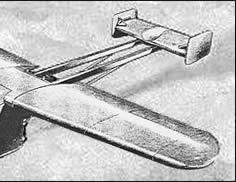
- Aircraft Annual, 1957

- Forked Ghosts, Christophe Meunier, 2004
|
|||||||||||||||||||||||||||||||||||||||||||||||||||||||||||||||||||||||||||||||||||||||||||||||||||||||||||
|
|
 
- Fred Steer (retouched JMC)
|
|
||
|
The above ‘potted’ history has been compiled from John Anderson’s recent interview of Bert Judge for the Neville Shute Norway Foundation, our own discussions with Bert, and last, but no means least, with the help of Fred Steer of Potty Productions [sic] who has, wonder of wonders, recently produced a Swallow kit for Jetex 50 power (right). Fred, whose website is full of good vintage stuff, writes: “The model has been designed to approx 1/10 scale, giving a wingspan of 22.5''. Built from balsa, [the wing is sheet over ribs] with vac-formed nose parts, tail gyrocover, brass catapult spools and aluminium boom and fin braces, it weighs only 2 oz including a loaded vintage Jetex 50 unit. Only the smoke nozzle (just visible under the nose) has been left off the flying model, as this would be liable to damage, although the size, shape etc. are detailed on the GA drawing for those who wish to build a static model. The glide is amazing and the performance under power is Something Else”. The kit includes a four-page history, and, at £12.00, it appears very reasonable. Though Fred designed his unique Swallow for a Jetex 50, it might go well with a Rapier L-2. Or one of the new L-3s. Talking of Rapiers, there has been a worrying hiatus in production as Dr Zigmund expands and retools. This is quite depressing, and several well-known rocket fliers are down to their remnants. Fortunately, production has now resumed: it will be interesting to see if general availability and quality control will improve. |
||||
|
Steve Bage has been encouraging the good folk on the Small Flying Arts Forum (SFA) to make model jets. The response has been very good, and, despite the uncertainties about Rapiers, most are rocket powered, though there are a couple of catapult and rubber powered models. All but a few are ‘traditional builds’. Whilst this is most encouraging, it is a little disappointing that so few are ‘classic’ Jetex designs. Steve himself contributed a Bachem Natter (Richard Crossley’s design enlarged for L2), a BV 215 and an O/D Okha, the kamikaze design of 1945 (right). Having finished these (Steve reports the tailless BV 215 flies like a duration job, the Natter can cavort about the sky in a spectacular fashion from a catapult launch, and the Okha needed some sorting out but now flies well and will be a plan and article in RC Model Flier). Steve is considering a Keil Kraft DH 110 (available from Replikit) and the unusual and complex 1950s Comet Panther. Mike Stuart contributed an O/D Fiat G-91 to the SFA project, but also likes vintage designs, and has nearly finished his Skyleada YF-100 (right). He writes: “It has been test-glided in the garden, prior to painting and adding the canopy. Like the Mystère IV, it is nose heavy, and as the last thing I wanted was to add tail weight, I cut the tailplane loose and introduced a whole |
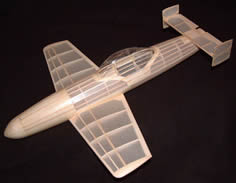
- Steve Bage
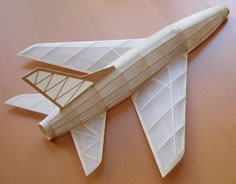
- Mike Stuart
|
|||
|
The next model is especially interesting: Laurence Mark’s re-creation (right), for Rapier L-2, of D P Golding’s classic Boulton Paul P.111A (Aeromodeller, May 1954) (see below). At 24", this was intended for a Jetex 200 or Jetmaster and augmenter tube. Laurence has reduced it to 12.5" and retained the partially sheeted wings, but modified the original monocoque fuselage to ‘formers and stringers’ with some filling in, and the motor is mounted in a trough. It weighs 32 g. The original reflexed airfoil is not reproduced either; instead, Laurence made a semi-symmetrical wing and turned up the (scale) elevons several degrees. |

- Laurence Marks
|
|||
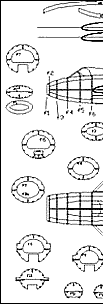
Laurence calls his delightful model ‘scrappy’, saying he will make a ‘proper’ model for Old Warden using less wood once he has sorted it out. I wish my models were as scrappy! As to its problems; it sounds like the CG is too far forward, and perhaps he needs to split the flaps and elevons, which allows differential reflex and thus washout to be easily adjusted. This little wrinkle worked a treat on my F.D.2, which is a very stable and predictable flier. |
|
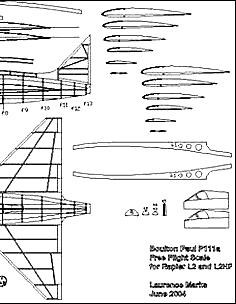
- Laurence Marks
|
||
Mr Golding does say in his article that small ailerons can be fitted as a trimming aid ‘if desired’, and to avoid a ‘nose up float’. His construction methods, too, are worth discussing in some detail, especially for anyone contemplating reproducing a Jetex ‘Tailored’ model. Mr Golding eschews his earlier ‘hollow log’ approach, and writes: “commence by carving a solid block fuselage, preferably from obechi. This is the only ‘awkward stage of construction, but is essential for true scale appearance. The block is carved |
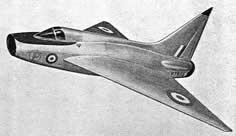
- Aeromodeller, May 1954

- Aeromodeller, May 1954
|
|||
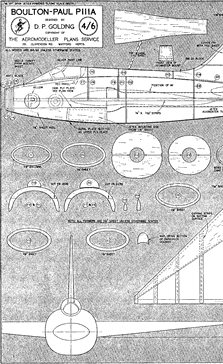
I had been casting about for a suitable vintage subject for some time, and all but decided on Howard Boys’ Vampire, when an Australian reader, Alwyn Smith, sent me the interesting design below. This first appeared in Hobbies Illustrated, (1949) and was, so the header to the article says, “Designed by M J Robinson in association with Bill Evans (Jet motor now available in Australia)”. Alwyn says of Mr Evans, “Bill had a company in Adelaide called Model Aircraft Industries, which had a hobby shop in Adelaide. He made kits of his designs, and the plans often appeared in various Australian magazines, like Hobbies Illustrated and his own publication, Australian Model Hobbies, which came out as nine issues between 1949 and 1953. He had a [bad!] habit of copying other people’s models and designs, and then publishing them under his own name. It would not surprise if this one is a slight redraw of the Wilmot Mansour design.” |
|
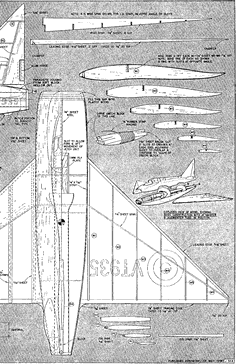
- Aeromodeller, May 1954
|
||

The accompanying article for this model of what it calls “Britain’s outstanding jet fighter plane” begins promisingly enough: “The availability of these model jet motors makes it possible for the aeromodeller to construct many interesting types of model, which previously had to be spoilt by the adding of rubber motors or some other form of power which was quite different to the original aircraft, and so spoilt its authenticity. The Vampire is very close to true scale and is one of the most attractive models to take to the air”. However, as is typical with these sorts of publications, the building and flying instructions are sketchy, and the instructions for finishing merely state, “The Australian Vampires are finished in all-silver with blue and white roundels and black markings”. Perhaps this model, and, indeed, Hobbies Illustrated generally, were aimed at experts. But even they could not have been, at that time, expert in Jetex. The trimming instructions, having recommended a balance point at the traditional ‘one-third of the chord back from the leading edge’, continue, “Now is the time to keep your fingers crossed. [!] Seek out a field of tall soft grass and proceed to test-glide … correct any tendency to nose up or down with adjustments to the elevator. The flight pattern of a jet model is different to a propeller driven aircraft, as there is no torque, and any maladjustment quickly becomes obvious. Slight upthrust (jet pointing downwards) seems to give best results. Light the jet, wait for maximum thrust and launch nose down into the wind”. It seems to me that these pointers are just not good enough for someone attempting his first Jetex model, and Bill Winter’s recommendations on flying his Swish (see Smoky Addiction 7) are much more useful and honest. Bill Evan’s article ends, “We would be pleased to hear of your experiences with the Vampire”. I wonder if he ever did receive any feedback from his Australian colleagues. One possible comment that springs to mind is, “where in the name of a dead dingo can I find a field of tall soft grass?” |
|

- Hobbies Illustrated, 1949
This ambitious antipodean offering is preferable to the (slightly later) Wilmot Mansour kit (below) and more practicable than Cockle’s 1948 Aeromodeller design. It could, given a few modifications, for example reduction to about 14-16" wing-span, removal of most of the fuselage’s internal structure, the addition of a trough and a bit more wing incidence and dihedral, be a viable, and nicely vintage, model for Rapier L-2. 
- Model Aircraft, May 1951
|
||
|
|
||||
|
|
|
|||
|
|
|
|
|
|
|
|
Acknowledgements - Article: Roger Simmonds - Illustrations: Roger Simmonds, Mike Bage, MAAC archives via Bill Henderson, Laurence Marks, Alwyn Smith, Fred Steer, Mike Stuart |
|
|
|
|
ABOUT | MOTORS | MODELS | ARCHIVE | HISTORY | STORE | FAQ | LINKS |
|
|
Terms of Use
|
Queries? Corrections? Additions?
Please
contact us.
|
|